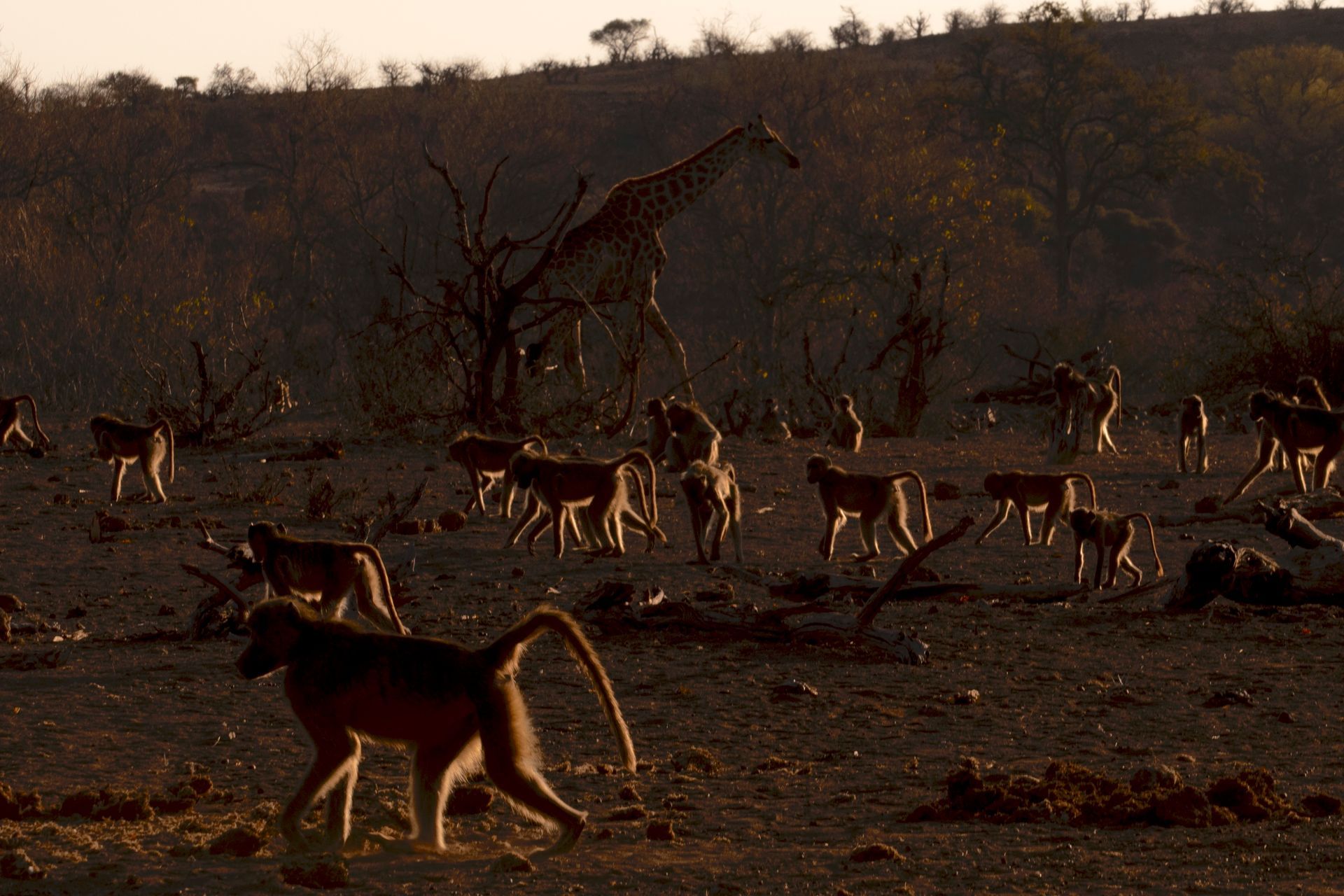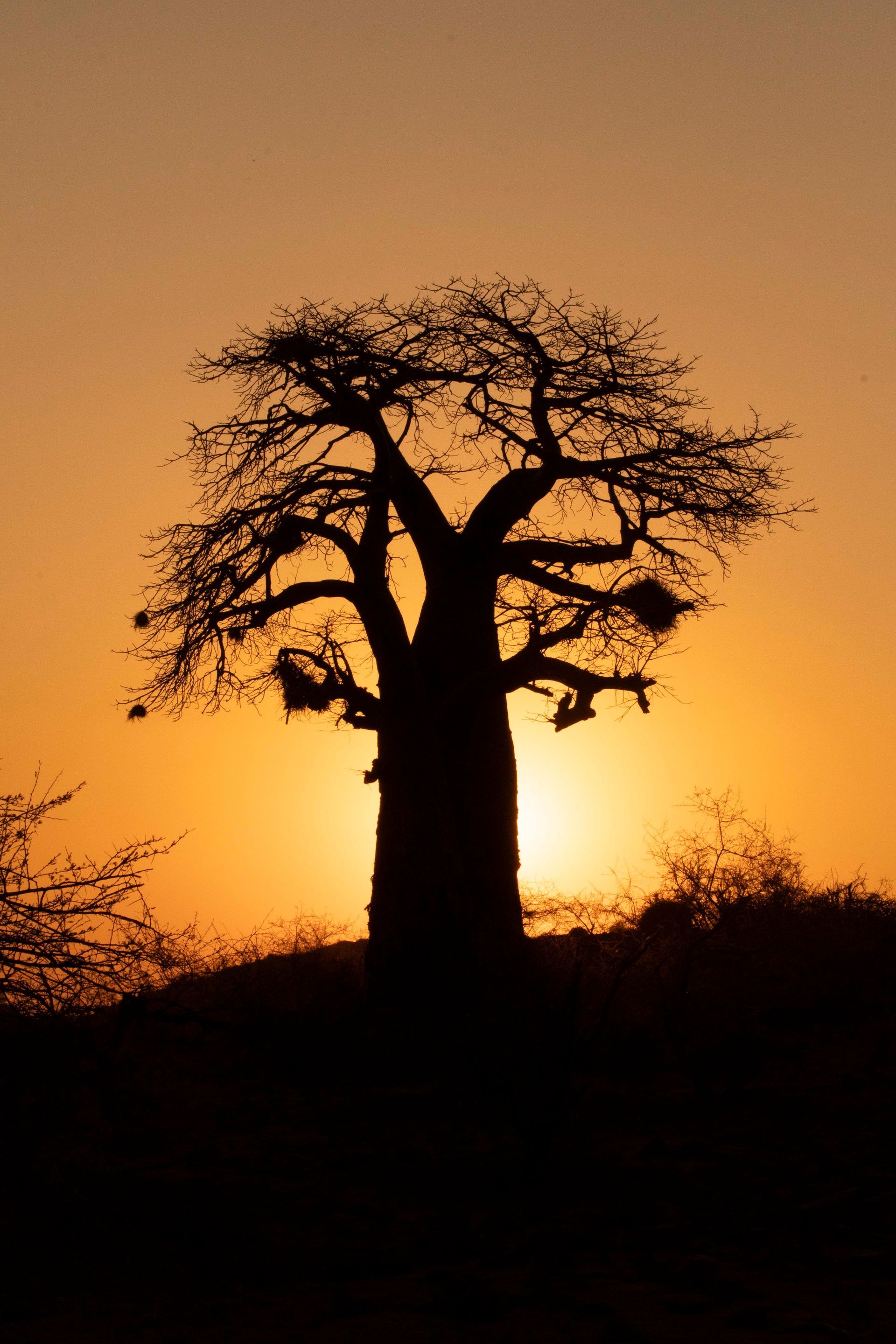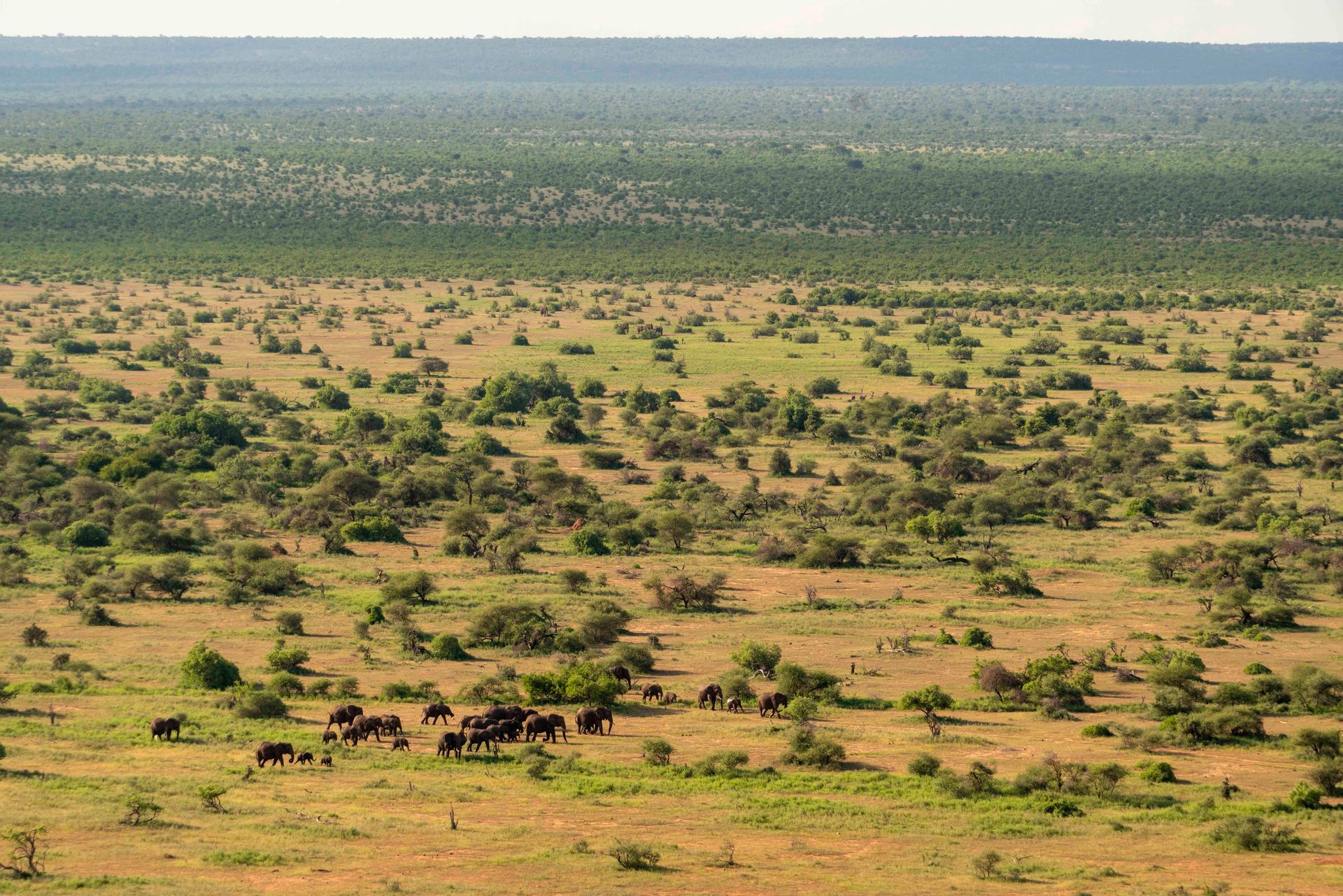TheTuli
Block
TheTuli
Block
TheTuli
Block
Botswana’s eastern wilderness frontier
The Tuli Block lies tucked into the far eastern corner of Botswana where the country meets South Africa and Zimbabwe. This lesser-known safari region is defined by its striking landscapes – rocky sandstone outcrops, ancient riverbeds, vast open plains and dense forests of mopane and fever trees. Shaped by the Limpopo and Shashe Rivers, the area offers a sharp contrast to the waterways of the Okavango or the salt pans of Makgadikgadi, giving Tuli its own distinct character.
Known as the Land of Giants for its towering baobabs and large elephant herds, the Tuli Block combines dramatic scenery with a rich diversity of wildlife. But this region offers more than game viewing alone – archaeological sites, Stone Age tools and ancient rock art speak of thousands of years of human presence, while its remote location promises a quiet, uncrowded safari experience far from mainstream routes.
What makes it stand out
Tuli’s varied terrain supports a wide range of species, from the vast elephant herds that roam the floodplains to elusive predators like leopard and caracal in the rocky kopjes. Lion and cheetah are regularly seen, as are spotted and brown hyena. The reserve’s mix of open plains, woodlands and riverine forest is also home to rare antelope such as eland, sable and roan.
Nightfall brings a different rhythm to the bush. Nocturnal species such as aardvark, genet, porcupine and civet emerge under the stars, offering a chance to experience the wilderness at its most mysterious.
Birdwatching is exceptional. The riverbanks host bee-eaters, kingfishers and weavers, while raptors soar on thermals above the cliffs. Giant eagle owls roost in the forest, and ground hornbills stride purposefully through the savannah. The haunting call of the African fish eagle echoes through the valleys, reminding you that water still shapes life here, even in this drier part of the country.
What makes it stand out
Tuli’s varied terrain supports a wide range of species, from the vast elephant herds that roam the floodplains to elusive predators like leopard and caracal in the rocky kopjes. Lion and cheetah are regularly seen, as are spotted and brown hyena. The reserve’s mix of open plains, woodlands and riverine forest is also home to rare antelope such as eland, sable and roan.
Nightfall brings a different rhythm to the bush. Nocturnal species such as aardvark, genet, porcupine and civet emerge under the stars, offering a chance to experience the wilderness at its most mysterious.
Birdwatching is exceptional. The riverbanks host bee-eaters, kingfishers and weavers, while raptors soar on thermals above the cliffs. Giant eagle owls roost in the forest, and ground hornbills stride purposefully through the savannah. The haunting call of the African fish eagle echoes through the valleys, reminding you that water still shapes life here, even in this drier part of the country.
What makes it stand out
Tuli’s varied terrain supports a wide range of species, from the vast elephant herds that roam the floodplains to elusive predators like leopard and caracal in the rocky kopjes. Lion and cheetah are regularly seen, as are spotted and brown hyena. The reserve’s mix of open plains, woodlands and riverine forest is also home to rare antelope such as eland, sable and roan.
Nightfall brings a different rhythm to the bush. Nocturnal species such as aardvark, genet, porcupine and civet emerge under the stars, offering a chance to experience the wilderness at its most mysterious.
Birdwatching is exceptional. The riverbanks host bee-eaters, kingfishers and weavers, while raptors soar on thermals above the cliffs. Giant eagle owls roost in the forest, and ground hornbills stride purposefully through the savannah. The haunting call of the African fish eagle echoes through the valleys, reminding you that water still shapes life here, even in this drier part of the country.
Some background
The Tuli Block is a narrow strip of land set aside in colonial times as a buffer between Bechuanaland and its neighbours. Today, much of it is privately owned but managed as a conservation area through a group of collaborative reserves including the Northern Tuli Game Reserve and Mashatu Game Reserve.
Tuli’s geological story stretches back millions of years. The region is known for its dramatic basalt and sandstone formations, including the Lepokole Hills and Solomon’s Wall – towering cliffs formed by ancient volcanic activity. These natural features have shaped not only the landscape but also the patterns of animal movement and human settlement.
This part of Botswana has long been home to Indigenous communities, including the Basarwa (San) and Batswana, whose stone tools, rock engravings and spiritual sites are scattered across the reserve. Local guides often share these stories, bringing Tuli’s cultural heritage to life alongside its natural wonders.
Some background
The Tuli Block is a narrow strip of land set aside in colonial times as a buffer between Bechuanaland and its neighbours. Today, much of it is privately owned but managed as a conservation area through a group of collaborative reserves including the Northern Tuli Game Reserve and Mashatu Game Reserve.
Tuli’s geological story stretches back millions of years. The region is known for its dramatic basalt and sandstone formations, including the Lepokole Hills and Solomon’s Wall – towering cliffs formed by ancient volcanic activity. These natural features have shaped not only the landscape but also the patterns of animal movement and human settlement.
This part of Botswana has long been home to Indigenous communities, including the Basarwa (San) and Batswana, whose stone tools, rock engravings and spiritual sites are scattered across the reserve. Local guides often share these stories, bringing Tuli’s cultural heritage to life alongside its natural wonders.
Some background
The Tuli Block is a narrow strip of land set aside in colonial times as a buffer between Bechuanaland and its neighbours. Today, much of it is privately owned but managed as a conservation area through a group of collaborative reserves including the Northern Tuli Game Reserve and Mashatu Game Reserve.
Tuli’s geological story stretches back millions of years. The region is known for its dramatic basalt and sandstone formations, including the Lepokole Hills and Solomon’s Wall – towering cliffs formed by ancient volcanic activity. These natural features have shaped not only the landscape but also the patterns of animal movement and human settlement.
This part of Botswana has long been home to Indigenous communities, including the Basarwa (San) and Batswana, whose stone tools, rock engravings and spiritual sites are scattered across the reserve. Local guides often share these stories, bringing Tuli’s cultural heritage to life alongside its natural wonders.
What kind of safari to expect
A safari in the Tuli Block is immersive, adventurous and full of variety. The private nature of the reserves means guests enjoy flexible activities not permitted in national parks. You can venture off-road to track wildlife, head out on foot with a guide, cycle along elephant paths, or saddle up for a horse safari through the open plains.
Game viewing is excellent year-round. Elephants are ever-present, drawn to the rivers and forests. Predators follow the antelope herds, and the lack of heavy tourist traffic means that sightings feel unhurried and intimate. Morning and afternoon drives offer the chance to explore different habitats, while night drives reveal the secret life of the bush after dark.
Accommodation ranges from elegant tented camps to remote wilderness lodges, each offering personalised service and the sense of being part of a truly wild corner of Botswana. The guiding here is exceptional – many guides are local, with deep knowledge of the land and an obvious pride in its conservation.
What kind of safari to expect
A safari in the Tuli Block is immersive, adventurous and full of variety. The private nature of the reserves means guests enjoy flexible activities not permitted in national parks. You can venture off-road to track wildlife, head out on foot with a guide, cycle along elephant paths, or saddle up for a horse safari through the open plains.
Game viewing is excellent year-round. Elephants are ever-present, drawn to the rivers and forests. Predators follow the antelope herds, and the lack of heavy tourist traffic means that sightings feel unhurried and intimate. Morning and afternoon drives offer the chance to explore different habitats, while night drives reveal the secret life of the bush after dark.
Accommodation ranges from elegant tented camps to remote wilderness lodges, each offering personalised service and the sense of being part of a truly wild corner of Botswana. The guiding here is exceptional – many guides are local, with deep knowledge of the land and an obvious pride in its conservation.
What kind of safari to expect
A safari in the Tuli Block is immersive, adventurous and full of variety. The private nature of the reserves means guests enjoy flexible activities not permitted in national parks. You can venture off-road to track wildlife, head out on foot with a guide, cycle along elephant paths, or saddle up for a horse safari through the open plains.
Game viewing is excellent year-round. Elephants are ever-present, drawn to the rivers and forests. Predators follow the antelope herds, and the lack of heavy tourist traffic means that sightings feel unhurried and intimate. Morning and afternoon drives offer the chance to explore different habitats, while night drives reveal the secret life of the bush after dark.
Accommodation ranges from elegant tented camps to remote wilderness lodges, each offering personalised service and the sense of being part of a truly wild corner of Botswana. The guiding here is exceptional – many guides are local, with deep knowledge of the land and an obvious pride in its conservation.
Things to do and see
There’s much more to Tuli than traditional game drives. Guided walks take you into areas where vehicles can’t reach, allowing you to discover animal tracks, learn about medicinal plants, or watch the sun rise in total stillness.
Horse riding adds a new level of excitement, allowing you to move quietly and closely among the plains game. Mountain biking routes wind through mopane woodlands and along dry riverbeds, offering an active alternative for those who like to explore under their own steam.
Birders will find hundreds of species here, particularly around the Limpopo and Shashe Rivers, where flocks of carmine bee-eaters, fish eagles and white-fronted plovers add colour and movement to the banks.
For a different kind of connection to the landscape, visit the archaeological sites within the reserve. Rock shelters containing San rock art, old iron smelting sites and Stone Age tools offer a glimpse into the lives of those who lived here millennia ago. Local community visits provide further context and cultural depth, especially for travellers seeking a more holistic understanding of Botswana’s heritage.
Things to do and see
There’s much more to Tuli than traditional game drives. Guided walks take you into areas where vehicles can’t reach, allowing you to discover animal tracks, learn about medicinal plants, or watch the sun rise in total stillness.
Horse riding adds a new level of excitement, allowing you to move quietly and closely among the plains game. Mountain biking routes wind through mopane woodlands and along dry riverbeds, offering an active alternative for those who like to explore under their own steam.
Birders will find hundreds of species here, particularly around the Limpopo and Shashe Rivers, where flocks of carmine bee-eaters, fish eagles and white-fronted plovers add colour and movement to the banks.
For a different kind of connection to the landscape, visit the archaeological sites within the reserve. Rock shelters containing San rock art, old iron smelting sites and Stone Age tools offer a glimpse into the lives of those who lived here millennia ago. Local community visits provide further context and cultural depth, especially for travellers seeking a more holistic understanding of Botswana’s heritage.
Things to do and see
There’s much more to Tuli than traditional game drives. Guided walks take you into areas where vehicles can’t reach, allowing you to discover animal tracks, learn about medicinal plants, or watch the sun rise in total stillness.
Horse riding adds a new level of excitement, allowing you to move quietly and closely among the plains game. Mountain biking routes wind through mopane woodlands and along dry riverbeds, offering an active alternative for those who like to explore under their own steam.
Birders will find hundreds of species here, particularly around the Limpopo and Shashe Rivers, where flocks of carmine bee-eaters, fish eagles and white-fronted plovers add colour and movement to the banks.
For a different kind of connection to the landscape, visit the archaeological sites within the reserve. Rock shelters containing San rock art, old iron smelting sites and Stone Age tools offer a glimpse into the lives of those who lived here millennia ago. Local community visits provide further context and cultural depth, especially for travellers seeking a more holistic understanding of Botswana’s heritage.
Why choose the Tuli Block
Tuli is one of Botswana’s best-kept secrets – a place of sweeping views, giant trees and powerful solitude. Its remoteness means fewer visitors and more space to explore. The diversity of activities, from walking and riding to cycling and night drives, makes it a dream for adventurous travellers looking to engage with the bush in a deeper way.
Wildlife sightings are excellent and often dramatic, but it’s the combination of nature, history and tranquillity that truly defines a safari here. The Tuli Block is where Botswana slows down and opens up, inviting you to reconnect with the wild on your own terms.
Why choose the Tuli Block
Tuli is one of Botswana’s best-kept secrets – a place of sweeping views, giant trees and powerful solitude. Its remoteness means fewer visitors and more space to explore. The diversity of activities, from walking and riding to cycling and night drives, makes it a dream for adventurous travellers looking to engage with the bush in a deeper way.
Wildlife sightings are excellent and often dramatic, but it’s the combination of nature, history and tranquillity that truly defines a safari here. The Tuli Block is where Botswana slows down and opens up, inviting you to reconnect with the wild on your own terms.
Why choose the Tuli Block
Tuli is one of Botswana’s best-kept secrets – a place of sweeping views, giant trees and powerful solitude. Its remoteness means fewer visitors and more space to explore. The diversity of activities, from walking and riding to cycling and night drives, makes it a dream for adventurous travellers looking to engage with the bush in a deeper way.
Wildlife sightings are excellent and often dramatic, but it’s the combination of nature, history and tranquillity that truly defines a safari here. The Tuli Block is where Botswana slows down and opens up, inviting you to reconnect with the wild on your own terms.








